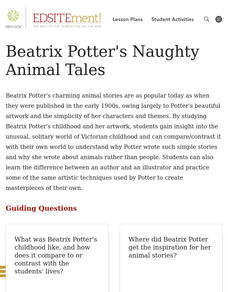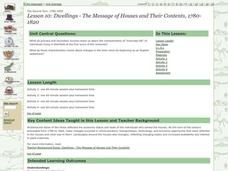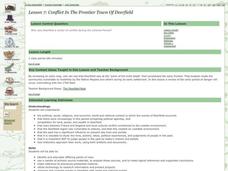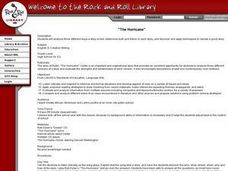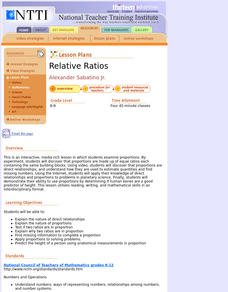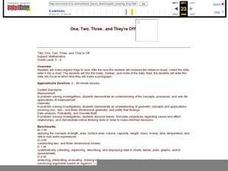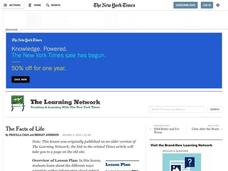Curated OER
Look Alikes
Third graders compare and contrast the physical features of parents and offspring. In this life science lesson, 3rd graders classify a set of animal pictures according to their similarities. They share and explain their work in class.
Curated OER
Whose Rights are Right?
Students consider the concept of 'human rights' in relation to the current conditions and history of East Timor and discuss the terms "human rights" and "force," applying their responses to specific historical examples.
Curated OER
Beatrix Potter's Naughty Animal Tales
Students gain insight into the unusual, solitary world of Beatrix Potter's Victorian childhood and can compare/contrast it with their own world to explain why Potter wrote such simple stories and why she wrote about animals rather than...
Curated OER
Significant What?
Students define accuracy and precision, and differentiate between the two terms, apply the concepts of accuracy and precision to a given situation and correctly apply the concept of significant figures to measurement and mathematical...
Curated OER
The Art of Social Protest
Students investigate how art and music define and unify a social movement. They decide how art and music can act as symbols of protest. They view both contemporary and historical examples of art as a tool for protest and design an art...
Curated OER
Nureyev: After Petipa
Students examine dance and choreography in Russian history. In this Russian history lesson, students discover details about Russian ballet and the work of Marius Petipa as they conduct independent research and present their findings to...
Curated OER
Can't You Make Them Behave, King George?
Fifth graders describe the changes in King George III's policy toward the American colonies by sequencing key events between the French and Indian War and the American Revolution. They explain the colonial reactions to command decisions...
Curated OER
Activity #4 What Do Equations Mean?
Learners practice with writing and balancing simple chemcial equations. they comprehend that chemical equations are a method of using a set of univeral symbols to represent what happens experimentally in chemical reactions. Pupils...
Curated OER
Dwellings - The Message of Houses and Their Contents, 1780-1820
Eleventh graders explore how architectural styles of the times reflected the economic status and taste of the individuals who owned the houses and how changes in the landscape and in material wealth reflect changes in technology and in...
Curated OER
Conflict in the Frontier town of Deerfield
Young scholars use primary sources to investigate, explore and represent varying perspectives on the 1704 Deerfield Raid. They consider the reasons Deerfield was at the center of English, French and Native American conflicts in the early...
Curated OER
Picking Pythagoras
Students discover that side measurement is used in determining angle classification of a triangle. By squaring sides, they predict whether triangles be right, obtuse, or acute. They prove the Pythagorean Theorem and use it to solve...
Curated OER
The Hurricane
Students analyze three different ways a story is told, determine truth and fiction in each story, and discover and apply techniques to narrate a good story.
Students listen to Bob Dylan's "The Hurricane" and watch the "R" rated movie,...
Curated OER
Reflecting on Reflectivity
Students plan and construct a "mini-lab" to measure the reflectivity of different earth surfaces. They measure reflectivity of materials, including ice, soil, rocks, etc., and then extrapolate from what they have learned to consider the...
National Endowment for the Humanities
Faulkner's As I Lay Dying: Images of Faulkner and the South
Learners research one aspect of the life of Faulkner and the culture of the South. In this As I Lay Dying instructional activity, learners explore a webpage on Faulkner and write a summary. Learners analyze the images...
Curated OER
Casting a Ballot for New Freedoms
Students use a New York Times article about the first free election in Indonesia in over four decades as a tool for learning about the government and politics, economy, religion, international relations, and people of Indonesia in the...
Curated OER
It Comes In Waves
Learners investigate the behavior and different origins of tsunami waves, and they then research and chart the path of certain tsunamis from recent history using the Internet, maps and firsthand accounts.
Curated OER
Relative Ratios
Learners discover that proportions are made up of equal ratios each containing the same building blocks. They, using the Internet, apply their knowledge of direct relationships and proportions to problems in planetary science.
Curated OER
Come On, You Can Trust Me
Fourth graders see how to define and then recognize a variety of propaganda techniques at work in their everyday world. Choosing one technique, they creatively demonstrate a thorough understanding from real world experiences. A very rich...
Curated OER
One, Two, Three...and They're Off
Students make origami frogs to race. After the race they measure the distance raced, collect the data, enter it into a chart. They then find the mean, median, and mode of the data. Next, students enter this data into Excel at which time...
Curated OER
The Facts of Life
Students explore the different ways scientists gather information about extinct animals. They utilize these methods to create illustrated story books about a particular extinct animal.
Curated OER
Creative Characterization
Students write a character description journal in which they take on the voice of one of the character's made-up friends or relatives. They write a sketch of that character from the friend or relatives' point of view.
Curated OER
Tall Tales and Urban Legends
Students identify and interpret what tall tales, urban legends, and cyberlore are and to find them in their own lives. They practice telling and listening to these types of tales and explore why people tell them. Students also identify...
Curated OER
Principles of Flight: Where are We?
Students explore the concept of topographical maps. In this topographical map lesson plan, students discuss how airplanes know where to fly. Students use topographical maps to simulate a field trip on the computer.
Curated OER
Prototypes and Model Designs
Fifth graders examine prototypes and model designs. In this engineering lesson plan, 5th graders build a prototype out of a deck of cards and test their design. Upon completion, students write a letter to an architect which includes the...




